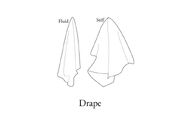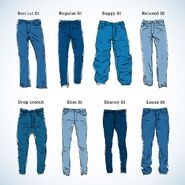Note: This article is an educational tool intended to improve the understanding of aesthetics. It is not about a particular aesthetic.
Fashion is the process of choosing, obtaining, and arranging garments in a way that looks cohesive, conveys mood, and makes a statement on the wearer's personality and personal taste. It also includes makeup, hair styling, and accessorizing, which further expresses a person's appearance to others in society.
Clothing has a long history, with multiple political and cultural connotations in what garments a person chooses to wear. Trends, which are typical details and elements that are typical of an era/year's clothing, is a major indicator of a person blending into mainstream society. Likewise, a person can reject the typical trends and wear what is called alternative fashion, a clothing style that is seen as outside of the norm.
Fashion is one of the most popular ways to convey an aesthetic. Different aesthetics on this wiki express themselves through these different garments based on these cultural connotations, Colour Theory, and function. So, practitioners of specific aesthetics follow trends, listen to taste-makers, and shop at certain brands that are popular within their community.
Elements of Fashion[]
Color[]
See Colour Theory for information on color palettes, types of colors, and what different colors convey about your style.
One thing to note is that different colors will look more flattering on different skin tones. Magazines and fashion enthusiasts have created a system called "seasons", where there are different types of hues that will look on you based on if you have a warm or cool and light or dark skin tone. While knowing your season is not necessary and may be exaggerated, it does help identify how different colors contrast against the skin and identifies what colors may look better on certain people.
Fabric & Texture[]
Fabric is woven or knitted threads that make up the body of the garment. Due to their different thickness, materials, and how they are woven, there is a wide variation on how different types of fabric look and feel, which is called texture. There are different attributes due to these qualities, such as sheerness, stretchiness, drape, and breathability. Some fabrics are also better suited to certain types of garments due to these differences, as these fabrics' properties will affect the functionality and appearance of the fabric. Temperature and utility are also important factors in choosing fabric, as durability and its ability to insulate body heat are also dependent on the way it was woven and its material. Some fabrics have certain connotations due to these different purposes. For example, tweed is associated with academics and flannel with lumberjacks.
Many textiles are also not woven threads and made of different materials. Some include fur, leather, and vinyl. These tend to be "statement" fabrics in clothing due to the difficulty in sewing with them.
Pattern & Prints[]
Patterns are shapes and lines that are woven into the fabric through weaving threads that are of different colors or printed on one side only through different techniques in dyes. Many aesthetics are associated with certain patterns due to their cultural connotations, such as Scottish tartan or "picnic-y" gingham. Different societies experimented with patterns in their artwork and can be identified by the different geometric or swirling florals associated with the time period.
Embellishment[]
Embellishments are different techniques that decorate and add visual interest to garments. They are associated with a more formal and extravagant aesthetic due to the amount of labor and skill involved in adding these details to garments. Some examples include beading, embroidery, fringe, and lace. These are seen as delicate and feminine in recent fashion history, yet multiple cultures traditionally embroidered men's clothing, such as Mariachi dress in Mexico.
There is also a type of embellishment known as hardware, which is made of metal. Zippers, eyelets, and studs are examples of embellishments and are typically associated with punk. A large amount of hardware is typically seen as intimidating due to the spiky and hard surfaces of the metal.
Silhouette & Fit[]
Silhouette is the way that fabric is fitted on the body and makes shapes due to how the sewing pattern was designed. Gathers and extra fabric and lengths create looser silhouettes, whereas cuts that are closer to the wearer's measurements have a tighter silhouette that emphasizes the body. Certain silhouettes are achieved via specialized undergarments such as petticoats and corsets, creating a more artificial shape that is not dependent on the wearer's body.
Silhouettes can change how a person's body appears due to the fabric emphasizing or hiding certain areas of the body. This can make a person's appearance look more flattering to different trends of different eras.
Historical, Regional, & Political Connotations[]
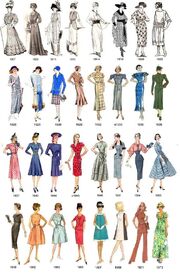
A brief history of American fashion from 1907-1973, showing how clothing can change over time and reflect social changes.
Fashion has shifted throughout human history, often tying into what the society of the time considers beautiful, attractive, and socially relevant. What garments a person wears indicates how one fits into mainstream, alternative, or social societies and classes.
History[]
Different silhouettes, details, accessories, and even colors are typically associated with specific eras and decades due to their culture's trends and aesthetic ideals of the time period. This is influenced by historical events, zeitgeists, notable people, and utilitarian needs. As said above, different societies adopt and abandon trends, which creates a cohesive look associated with that period. Thus, choosing the same details of a period different from one's own will make a person appear to appreciate specific styles of that period and differentiate themself from normal society. (See Vintage.) However, certain "revivals" are also popular within mainstream society, with fashion houses and brands borrowing different aspects of a previous era to appear more unique and visually pleasing.
To know more about different styles from different times of history, see here for research on Western fashion history or further research with other books, research websites, and primary sources such as sewing patterns and magazines.
Region[]
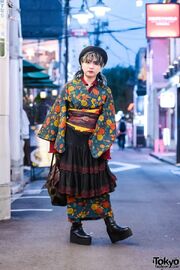
A Japanese woman wearing a kimono in a modern interpretation. From Tokyo Fashion, December 6, 2020
Societies often are identifiable by their different styles of dress, as different cultures create different styles based on aesthetic values specific to their traditions. It is largely influenced by the history of the country's fashion, practices, and economies. So, wearing different garments that belong to different cultures shows an aesthetic appreciation and an alignment with that nation's ideals. This is seen through different techniques, materials, garment styles, and symbolic motifs. Wearing region-specific clothing, called folk costume/ethnic dress, is typical in multiple national celebrations as a way to connect with that country and the generations before the wearer. Contemporary peoples can also create new interpretations of national dress as a way of expressing their ethnic identity and self-expression. See here for some examples.
Different contemporary and more Western styles can also be distinct from that country due to the pop culture and fashion designers within the region. Examples include Hallyu and Kei fashions.
One does have to be careful in wearing a different region's clothing. If done as a way to mock, profit off of, and disassociate it from the country of origin, it will be seen as offensive as the wearer does not pay proper respect to the cultural practice. To avoid this mistake, one has to share, rather than appropriate, by knowing the context of the garment and acting appropriately. For instance, if a certain item has religious purposes or is specifically kept within members of a culture, one should not create and wear the object, as in the case of war bonnets. Another issue is the idea of majority peoples exerting their power over minorities and lesser-known peoples. Fashion houses that appropriate a culture's aesthetic without acknowledging the society will take credit for the style and give less revenue to that culture. The minority culture will be continued to be seen as lesser and insulted for their cultural practices, while people of the majority culture will be revered. See here for more information.
Politics[]
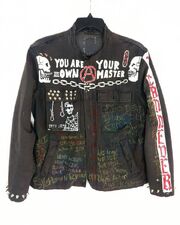
Punk jacket with an anarchy symbol and political slogans. Makes people aware that the wearer is a proponent of this political ideology.
As fashion is also an economic industry with the above cultural connotations, people often express their agreement and rebellion to societal norms through their style. Fashion can be an expression of gender, sexual liberation/conservatism, social class, and political ideology. So, people identify those in their social group through what products people own, how they perform gender and class, and how they differ/adhere to societal norms.
Gender - Clothing is often a notable expression of gender, which is the psychological state that a person identifies with based on their society's expectations of responsibilities and personalities of a person with biological sex characteristics. Certain garments, details, and colors are associated with different genders, which a person may wish to accept or reject. People express their gender identity through wearing items and arranging outfits, with varying levels of masculinity, femininity, and androgyny. Sexual orientation can also be expressed through gendered fashions, as people of that identity typically have a complex relationship with gender.
Sexual Liberation - A person may wish to express their sexual appeal through varying levels of coverage of the body. Those who are conservative (not necessarily in politics) cover their body further, such as long bottoms or long sleeves, due to personal preference, levels of comfort, and possible religious practices. In contrast, people who are more libertine may wish to expose certain parts of their body also as a way to be comfortable and because of personal preference. They may also wish to attract others and portray themselves as sexually active. People who are on the extremes of either side are frequently judged by others and may receive harassment because of their contrast to "mainstream" society's level of expectations in exposure.
Wealth and Class - Understanding clothing and being able to obtain it becomes easier with more wealth and a social group that judges a person based on their style. People who are in the upper classes typically know more about fashion, own higher-quality and more garments, and judge people based on adhering to current trends. Meanwhile, lower classes usually use clothing as a more utilitarian function, wear lower-quality garments, and style them in a way that is seen as visually unappealing. So, people utilize fashion as a means to fit into different social stratas and demonstrate their economic and social power.
Political Identity - There are also more overt ways of demonstrating one's political ties to a group. Different groups can put quotes, slogans, and symbols associated with political ideals via screen printing, embroidery, and pin-making. A person wearing these overt items signifies their loyalty to this political faction and brings awareness of their politics to others. This creates stronger social unity within the group, yet can also cause people outside their group to react negatively. There are also non-overt items that come to be associated with different political groups due to trends within their social circles and economic/environmental/gender/influencer connotations.
Ethics- Clothing, like everything else, is a material good that was made through changing raw materials into finished goods in human hands. As such, the ethics of how that raw material is acquired, how that impacts the environment, and how the people who made the clothing has been treated is a much-discussed topic. The individual choices that someone makes in how and where they buy clothing reflects how conscious they are of the ethics surrounding the creation of goods. Brand new cheaper clothing from fast fashion brands prioritize cheaper costs, which leads to low wages for the workers, cheap materials such as polyester, etc. Many companies have responded to that by being ethical, meaning it uses fair-trade practices in acquiring its raw materials and paying its laborers. Alternatively, many people choose to purchase exclusively secondhand, as ethical fashion is more expensive.
Of course, it is noted that "there is no ethical consumption under capitalism." Many people turn to cheaper unethical garments because it is all they can afford and find. Conversely, people also point out that it is the rich that can afford to be ethical, as they have the money to purchase ethical garments.
Personality Connotations[]
Confidence[]
Clothing is one of the visual ways people use to create impressions of and judge others. In combination with body language, people can deduce whether a person is outgoing or more introverted based on clothing. As fashion is also seen as an industry and activity for people who enjoy being social and sharing images of themselves with others, a greater interest in fashion and a more unusual and interesting outfit often means that a person is more confident. In contrast, people who have ill-fitting or unattractive garments typically are seen as insecure, against society's expectations, or unsocial.
Note that this is not necessarily true and is rather based on people's initial impressions of others. One can show their levels of confidence through other means, such as starting conversations, body language, etc. One can wish to dress in accordance with what they want their confidence to be, but being incongruous to the actual personality of the wearer means that that style is not well-suited to that person.
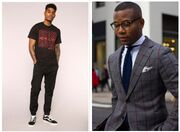
The man on the left's casual tee with meme slogans looks less mature than a man in a suit.
Maturity[]
Fashion tends to differ among ages, so people who tend to dress older or younger than what the norm is for their social group would be interpreted as being more or less mature than their peers. As fashion changes throughout time, what is considered "proper" for an age group will change constantly and relies on trends within the generation.
However, there are stereotypical traits that came to be associated with certain life stages because of typical activities and constant trends. People who dress more casually and colorfully tend to be seen as more youthful, while professional clothing in a muted color palette is seen as more mature.
Examples of fashion that are more mature are Corporate, Grandparentcore, and Minimalism. Examples of less mature fashion styles include Kidcore, Babycore, and Lolita.
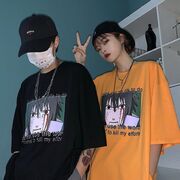
These people wearing Naruto tee shirts show their appreciation for the anime. Their accessories also fit into the Baddie and Streetwear aesthetic, showing their interest in a trendy and masculine fashion.
Hobbies & Interests[]
A person can also show their hobbies and interests that are unrelated to fashion through the kind of clothing they wear. As certain garments have different practical uses for multiple activities, a person who regularly wears that garment can be assumed to also participate in that activity. Screen printing, button-making, and embroidery can also express one's appreciation for different hobbies by putting inside jokes, references, imagery, symbolism, and art that is associated with that interest.
How to Find Your Style and Build a Wardrobe[]
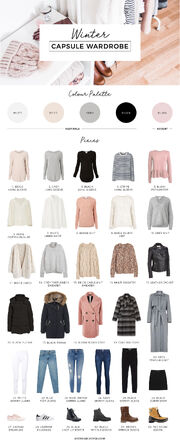
An example of a capsule wardrobe. Note the consistent color palette, the appropriate levels of warmth for the season, and the varying textures. Credit to Jayde Archives
Step 1: Finding Your Aesthetic[]
Finding your aesthetic is luckily the main purpose of the wiki. One can also utilize image-based websites such as Pinterest and Tumblr to find images to help you identify your aesthetic. To begin, search for objects, colors, and activities that you like and save these pictures to create a moodboard. Whom you follow and what the algorithm decides will show you images of people's outfits and garments. Named aesthetics, such as Dark Academia, Art Hoe, and Kei fashions are very helpful in that they have specific guides that will identify what you need if you choose to follow these styles. Traditional media such as fashion brands, magazines, celebrities/influencers, and works of fiction are also great sources of inspiration. After collecting photos, identify the garments' cuts, colors, embellishments, and other elements to know what types of elements to search for while shopping. A good example of a search term for shopping is "black tweed blazer," rather than "black jacket" which is a broader phrase.
Step 2: Identifying Your Lifestyle[]
To realistically express your style and aesthetic in real life, understand that levels of formality, the practicality of certain clothing pieces, and connotations need to adhere to your daily activities and social group. List what locations and activities you do in real life and see what functions you would need to do. Your climate and your personal levels of comfort are also important aspects to consider. This will limit what you will wear, as you will need to fit into the atmosphere and do certain activities in which your clothing may impede you. For example, you may like mini skirts and stilettos, but if you go to school and walk a lot, you will be unable to wear the garments you like. Unfortunately, fashion can also impact people's judgement of you, and you must be aware that if you wear something out of the norm, you may be judged depending on your social group. So, take inspiration in more achievable ways, such as using a photo's color palette, fabrics, different embellishments, and cuts that you can wear. For more information, visit here.
Step 3: Trying and Buying[]
After identifying what pieces you would like to try out, go shopping. This can be in either an in-person store or online. The benefit of the in-person store is that you have a fitting room so that you can see what the garment looks like on you without purchasing it. However, it would be limiting and more time-consuming as many stores only stock certain items under current trends and seasons. The benefit of online shops is that you can utilize a search function and find more variety. Just know that when you purchase something, you must be willing to return, sell, or donate the item. It is preferable to purchase higher quality secondhand items, as you may misidentify why you dislike an item if you purchase from fast fashion companies, which tend to use cheaper materials and poor construction.
Step 4: Knowing What Works and What Does Not[]
Using the items that you kept from step 3, incorporate those items into everyday life. If you return to the item constantly, feel comfortable, and enjoy your self-expression, this means the garment fits your aesthetic, lifestyle, and looks good on you. Whereas, if you are uncomfortable and push the item away from your everyday wardrobe, you should get rid of the garment. Identify why you like or dislike an item. Does it fit? Is it in your comfort zone? Is it practical in your everyday life? Does it look flattering on you? After listing your preferences, your shopping experience will be easier as you know what items to buy or avoid.
Step 5: Building Your Wardrobe[]
After acquiring enough items to create multiple functional outfits, you will have a consistent wardrobe with variations in colors, textures, and types of garments. As building a wardrobe varies based on personal taste and personality, it is better to ask yourself certain questions instead of following a guide. Some of them are: do you prefer a consistent wardrobe or more variety and experimenting? Do you find it hard to get dressed? Do you need different clothes for different events? How much do you want to spend on clothing? After seeing what issues and problems you have, add or get rid of garments by using Steps 3 and 4. In your lifetime, your garments will wear out, you will have different routines, and your style will change, so building a wardrobe is flexible and fluid.
One of the most prominent practices in fashion is a capsule wardrobe, in which a person has a wardrobe limited to four or five colors, and a minimal number of outfits to have the greatest efficiency possible. However, this may be limited to more experimental fashion enthusiasts, who can have multiple wardrobes of different styles.
Making Outfits[]
As making outfits is a highly subjective process that varies from person to person, this section will focus more on general tips and approaches with provided examples, rather than a general guide.
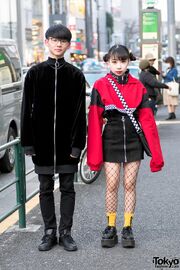
A man wearing monochrome black and a woman wearing a color palette of red, black, and yellow. From Tokyo Fashion, March 18, 2017.
Colors[]
As multiple garments make up an outfit, combining or contrasting garments that have different colors is one of the most important elements in creating an outfit.
Monochrome means dressing in only one color. It allows the wearer to play with textures, silhouettes, and embellishments in a cohesive look. Depending on the color, it can cause a person to stand out, such as in the case with bright red or neons. Colors that have strong symbolic connotations such as black or pink may cause people looking at the wearer to interpret them as having the same personality as the color, such as being negative and depressive with black or feminine and cheerful with pink.
Color palettes are one of the most popular ways to arrange colors in an outfit. See Colour Theory.
Accent colors are when a person pairs neutral, plain colors such as black, white, neutrals, and blue denim with one or two distinctive colors in smaller amounts. Unlike neutrals with distinctive colors, this typically is only with purses, shoes, and other small accessories. These colors include neon, jewel tones, and other saturated colors. The accent colors bring attention towards that garment and part of that body. This allows the wearer to showcase unique and special items, highlight their body parts, and avoid having a monotonous outfit.
Layering[]
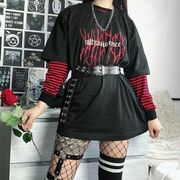
An E-girl layering socks over tights and a short sleeve tee over a long sleeve top. Red is an accent color with the black-focused outfit.
Layering is the process of wearing one garment over another. This allows for a greater combination of outfits in a wardrobe, more warmth, and a way to add additional texture and color to an outfit. Multiple items were designed to be layered, known as outerwear, but multiple garments could be worn over others as long as there is enough room to fit the garment over another. There is no set rule as different pieces of clothing uniquely fit everyone, so this requires experimenting with different items.
Some examples of layering are sleeveless dresses over tops or other dresses, short sleeve or sleeveless tops over long sleeve ones, skirts over dresses or pants, and socks over tights.


